FSP Aurum PT 1000W Power Supply Review
FSP's Aurum PT series PSUs are 80 PLUS Platinum-certified and fully modular. Today we will take a look at the series' 1000W mid-level unit.
Why you can trust Tom's Hardware
A Look Inside And Component Analysis
Our main tools for disassembling PSUs are a Thermaltronics soldering and rework station and a Hakko 808 desoldering gun.
| Primary Side | |
|---|---|
| Transient Filter | 4x Y caps, 3x X caps, 2x CM chokes, 1x MOV |
| Inrush Protection | NTC Thermistor & Relay |
| Bridge Rectifier(s) | 2x LL25XB60 (600V, 25A @ 113 °C) |
| APFC MOSFETs | 3x STMicroelectronics STF24NM60N (650V, 11A @ 100 °C, 0.19 Ohm ) |
| APFC Boost Diode | 1x CREE C3D08060A (600V, 8A @ 152 °C) |
| Hold-up Cap(s) | 2x Nippon Chemi-Con (420V, 470uF each, 2000h & 105 °C, KMQ) |
| Main Switchers | 4x Infineon IPP60R190C6, (650V, 12.8A @ 100 °C, 0.19 Ohm) |
| APFC Controller | Infineon ICE3PCS01 |
| Switching Controller | Champion CM6901 |
| Topology | Primary side: Full-Bridge & LLC Resonant ConverterSecondary side: Synchronous Rectification & DC-DC converters |
| Secondary Side | |
| +12V MOSFETs | 8x Infineon BSC014N04LS (40V, 100A @ 100 °C, 1.4mOhm) |
| 5V & 3.3V | DC-DC Converters: 6x Infineon BSC0901NSPWM Controller: APW7159 |
| Filtering Capacitors | Electrolytics: Nippon Chemi-Con (105 °C, KY, KZE), Rubycon (105 °C, YXG)Polymers: Nippon Chemi-Con |
| Supervisor IC | SITI PS223 (OVP, UVP, OCP, SCP, OTP ) |
| Fan Model | Power Logic PLA13525S12M (12V, 0.40A, 111.1 CFM, 41.6 dB(A), Hydro Dynamic Bearing) |
| 5VSB Circuit | |
| Rectifier | 1x AUIRFR1018E |
| Standby PWM Controller | TinySwitch-III TNY279PN |
| -12V Circuit | |
| PWM Controller | APW7174 |



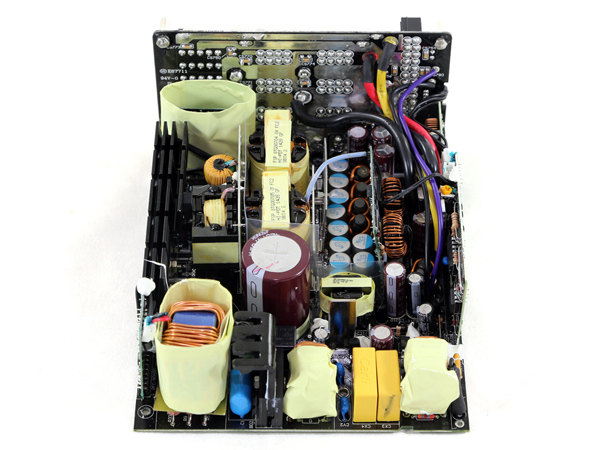

FSP used a full-bridge topology on the primary side along with an LLC converter for increased efficiency. The secondary side used DC-DC converters for the minor rails, while the MOSFETs that regulate the +12V rail are installed on the solder side of the main PCB. As a result, the PSU's chassis plays a key role in its cooling. Although some experienced OEMs like Seasonic have used this approach, we noticed that they avoid this method in their latest designs, installing the +12V FETs on heat sinks so they can be cooled more efficiently without need for increased airflow. Another design aspect that left a very good impression on us was that even the -12V rail is regulated by a dedicated VRM. Usually this insignificant rail is regulated by a simple diode. However, FSP decided to use a far more advanced method. Overall, this is a high-quality platform with top-notch components and a nice design.






The first part of the EMI filter consists of a single X cap and a pair of Y capacitors. The rest of the parts are on the main PCB, including two X and two Y caps, along with a pair of CM chokes and an MOV (metal oxide varistor). Close to the bulk caps, we found an NTC thermistor for protection against large inrush currents, plus an electromagnetic relay to isolate the thermistor from the circuit once it does its job.




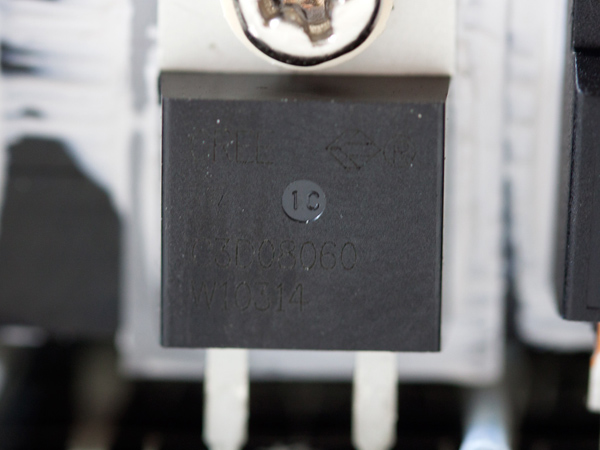

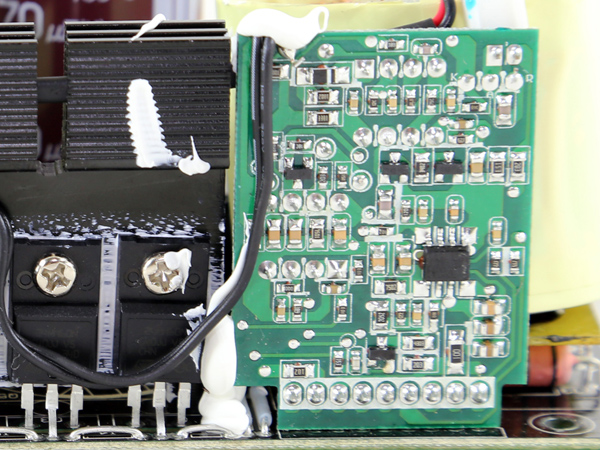
Two bridge rectifiers (LL25XB60) are bolted onto a dedicated heat sink. They are very powerful for the needs of this PSU, since their combined maximum output reaches 50A.
The APFC converter uses thee STMicroelectronics STF24NM60N FETs and a single C3D08060A boost diode. The bulk caps are provided by Chemi-Con (420V, 470uF each or 940uF combined, 2000h @ 105 degree C, KMQ series). An Infineon ICE2PCS01 is installed on a daughterboard located near the APFC converter area. On the front of the same board are the KA363A IC and an LM358N IC.
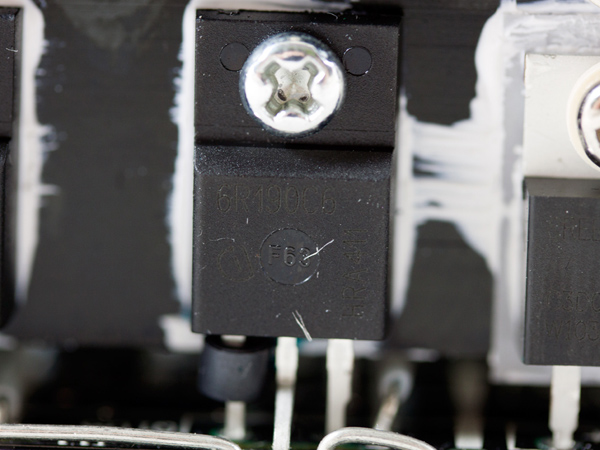




The main switchers, 4x Infineon IPP60R190C6, are arranged into a full-bridge topology and their switching losses are further restricted by an LLC resonant converter. The resonant controller is a Champion CM6901 IC, located on a vertical PCB, which also hosts an LM339N quad comparator and an LM358N dual-operational amplifier.







The two DC-DC converters are installed on a vertical PCB. The common PWM controller is an Anpec APW7159 and six Infineon BSC0901NS MOSFETs in total are used by both converters. The FETs that rectify the +12V rail (eight Infineon BSC014N04LS) are installed on the solder side of the main PCB.
Get Tom's Hardware's best news and in-depth reviews, straight to your inbox.
All filtering capacitors are provided by Japanese manufacturers. We found many polymer caps from Chemi-Con along with a few electrolytic Rubycons. The electrolytic caps are rated at 105 degrees Celsius.
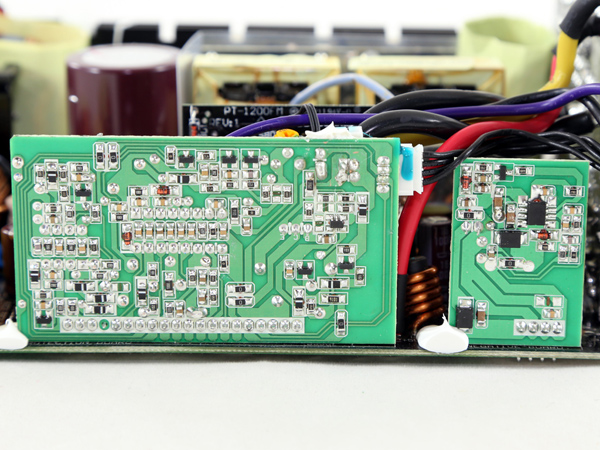
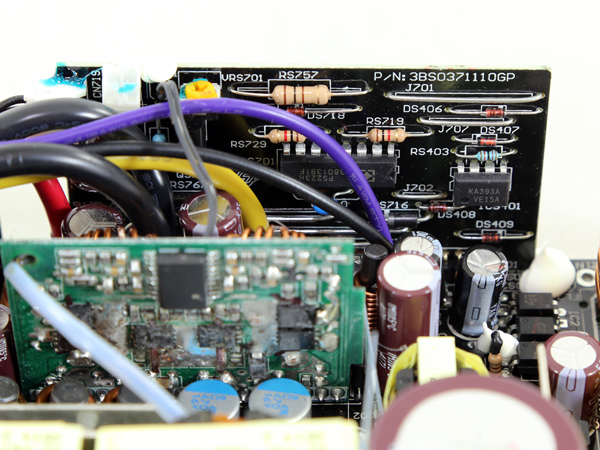




Housekeeping duties are handled by a SITI PS223 IC, which is among the very few supporting OTP (over-temperature protection) out of the box. The same protections IC supports OCP (over-current protection) for up to two +12V rails (even though this PSU only features a single +12V rail).
On the front side of the modular board, a number of polymer Chemi-Con capacitors, along with a single electrolytic cap from the same company, suppress ripple. In addition, to minimize energy loss, power is transferred to the modular board through several bus bars, located on the bottom of the board.





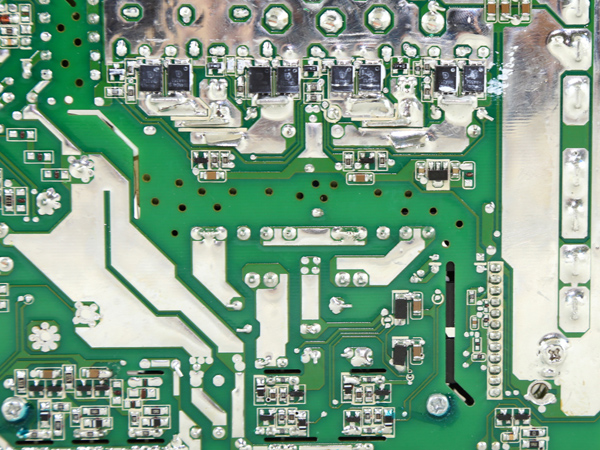
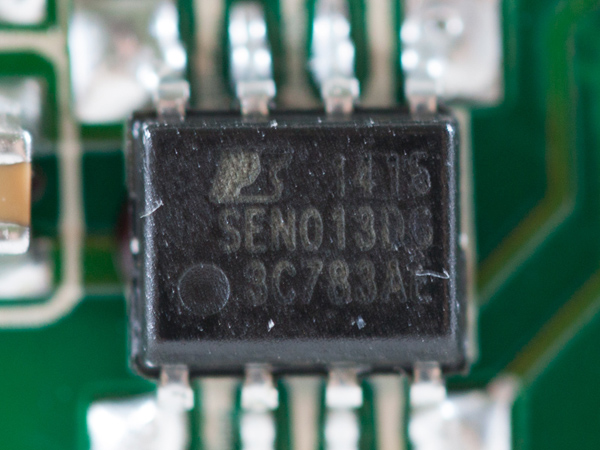
The -12V VRM includes an APW7174 PWM controller. It is very uncommon to see a dedicated VRM for this rail, even in high-end platforms. FSP clearly set the bar high here. The standby PWM controller is a TinySwitch-III TNY279PN, which cooperates with an AUIRFR1018E MOSFET located at the back of the mainboard. Although the 5VSB should be highly efficient, because of the MOSFET it uses for regulation instead of an SBR, our test results show that efficiency on this rail isn't up to our initial expectations.
Overall, soldering quality on the mainboard is good, although in some areas we spotted joints where too much solder was used.
The HDB fan is provided by Power Logic (PLA13525S12M, 135mm, 12V, 0.4A, 111.1 CFM, 41.6 dB[A]), and it's powerful even for a 1kW unit. The same fan is used in the PT-1200FM and, thanks to its high-quality bearing, should last for a long time.
Current page: A Look Inside And Component Analysis
Prev Page Packaging, Contents, Exterior And Cabling Next Page Load Regulation, Hold-Up Time And Inrush Current
Aris Mpitziopoulos is a contributing editor at Tom's Hardware, covering PSUs.
-
Giannis Karagiannis Just ordered one! Very comprehensive review! It is a bit strange that thanks to your recent articles I can choose a power supply with much greater confidence than a CPU or VGA. Keep up the good work!Reply -
Vosgy ReplyJust ordered one! Very comprehensive review! It is a bit strange that thanks to your recent articles I can choose a power supply with much greater confidence than a CPU or VGA. Keep up the good work!
Man haven't seen anyone call them Video Graphics Accelerators in years, kudos to you good sir. -
Covaylent Nice work, Aris, as usual.Reply
Would you mind commenting on the infrared images? Some of those hotspots seem quite hot - am I just reading the images incorrectly? -
Aris_Mp Indeed some hotspots are very hot since I usually take this shots with the PSU operating at very high ambient temperatures. Some parts inside the PSU may operate at up to 100C under such conditions.Reply
